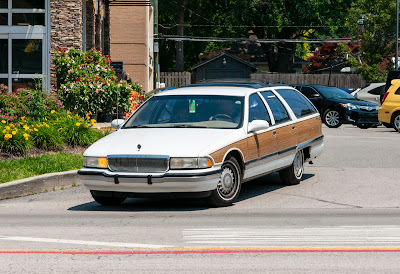All through the Malaise Era, while the US domestic automakers floundered through quality control problems and a crisis of relevancy as the market sought smaller, more fuel-efficient cars, the Japanese automakers gained ground in the American market. By the mid-Eighties, they'd surpassed the domestics in consumer perception of quality and were starting to challenge some of the revered Euro marques.
 |
| A Road & Track comparison test of a Benz 190E and a Honda Accord SE-i from 1985 |
Honda was ready to move upmarket, but knew that the badge-conscious US market wouldn't know how to deal with "luxury Hondas", so they created a new division of the company, Acura. It sold the new Legend, an upscale V6 midsize sedan, and the
Integra, a sporty hot hatch derived from Civic genes.
For 1991, Acura dealerships also got the new NSX mid-engine sports car, and then for '92 came the Vigor. Honda had been selling the Vigor, a sportier and more luxurious Accord derivative, at home since the early Eighties, but this new third generation (CC2) version was its first appearance on US shores.
Slightly wider than an Accord, the CC2 Vigor was also stretched forward of the firewall and, unusually for a Honda, featured a longitudinally-mounted engine driving the front wheels. Even more unusually for a Honda, this engine was an inline-five cylinder, the company's G25A1. A SOHC 20V motor with Honda's PGM-FI and a dual-stage induction system, the 2.5L I-5 was rated at 176 SAE net horsepower at 6300 rpm. The Vigor could be had with a standard five-speed manual or an optional four-speed auto with a lockup torque converter.
Car and Driver tested the Vigor in a six-way shootout of sub-$25k sports sedans against the Audi 80, the Mitsubishi Galant VR4, the Nissan Maxima SE, the Subaru Legacy Sport Sedan, and the Infiniti G20.
The Vigor's performance was only moderately...er, vigorous, laying down a 7.7 second zero-to-sixty and a 16.1 quarter mile at 88 mph through the traps (although it did not, notably, proceed to go back in time.) It got dinged on its handling, posting subpar slalom numbers and a second-worst 0.76g skidpad performance, but mostly on its price which, at $23,575, was the highest base sticker in the batch. That's $54k in 2025 bucks, by the way.
In the end, the Vigor finished third in the test, behind the Mitsu VR4 and Nissan's "Four Door Sports Car", and it also finished third in Acura showrooms, behind the plusher Legend and sportier Integra. The Vigor didn't set the world on fire sales-wise, and its tenure on our shores was brief, being discontinued after the '94 model year, making this Cassis Red example a rare sight.
























